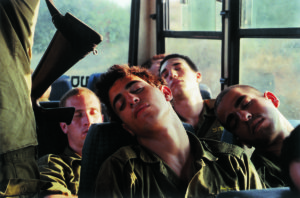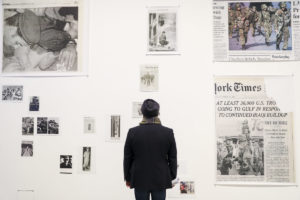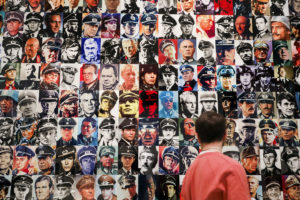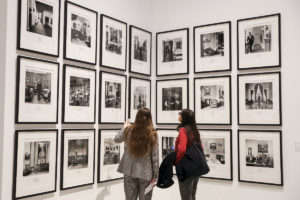The Barbican Center presents Masculinities: Liberation through Photography, an exhibition that aims at reflecting the representation of masculinity in the contemporary context. For decades now, the issue of gender roles has sparked the artistic, cultural and social debate, but only few exhibitions, in reality, reflected on what traditionally is the dominant figure of the debate. Through a meticulous analysis, the review discusses the representation of masculinity through a panorama that extends from the 1960s to the contemporary context, suggesting a heterogeneous and inclusive approach. Interesting is the fact that photography is the medium chosen for this investigation, which has always been considered a privileged artistic form for the representation of the social condition of man. But with the term man, the tradition has usually understood a white, upper-middle class, healthy, heterosexual, observer, colonizer and voyeur individual. Accompanied by a series of videos, here on display, the practice of photography “frees” the subject of investigation and even its own canons, to be complicit in a reflection on the identity of man.
The exhibition begins with an analysis of the archetypes and stereotypes that have always defined the male figure. Among the first, the figure of the soldier. The Israeli artist Adi Nes, proposes a new representation in the Soldier series (1999), which portrays genre scenes wherein groups of soldiers are caught in a moment of rest, be they sleeping, smoking or blinded by the sun on a bus for the Israel Defense Force mission. This vision contrasts with the “macho” and propagandistic version of the soldier usually proposed by the media, to the extent of including themes such as homosexuality and sexuality. This representation is aligned with the photographs and the collages of the famous German artist Wolfgang Tillmans who here presents the series Soldiers – The Nineties series (1999-2020). As usual, here the artist presents us with the most intimate aspects of masculinity, revealing a sensitivity hidden under military action which a reader can interpret from the portrays of soldiers involved in the Bosnian War, in Ireland of North, or in the Gulf War.
The black and white video by the Dutch artist Bas Jan Ader I Am Too Sad to Tell You (1971) reflects on human tragedy through the performative acts of a man in whom critics glimpse we can guess the family drama of the artist who seems here to recall the father killed by the Nazis during the Second World War. On a completely different tone, although maintaining the aesthetic expressiveness of the use of black-white photography, it is the following section which deals with masculinity through the topics of power and patriarchy, showing the internal contradictions of Western society.
On the one hand, the series of twenty-six photographs, Gentlemen (1981-1983) by the American artist Karen Knorr, intends to represent a well-defined élite. Shooted in the most exclusive clubs in London, her images become evidence of official power, accompanied by a series of poetic verses by the artist. On the other hand, Robert Mapplethorpe‘s photographs take us into the American context, talking about a different model of representation of masculinity, through the series of portraits Lisa Lyon (1980) and Arnold Schwarzenegger (1976) where to rethink the cult of the body. Here we rediscover the propagandistic and celebratory function of photography in the series The Family (1976) by the famous American artist Richard Avedon who presents a series of sixty-nine official portraits of the American elite in the late 70s, then published by Rolling Stone magazine, which became evidence of the period between Watergate and the 1976 election.
We continue by discussing masculinity within the family and in particular on the role of fatherhood. In the photographs of the British artist Anna Fox, My Mother’s Cupboards and My Father’s Words (1999) we can observe a cross-section of the internal dynamics of the family, in which the subjective and psychological violence that reduces the hegemonic male-dominated tradition is critically analyzed. The exhibition ends with the poetic series of photographs by the American Duane Michals, Grandpa Goes to Heaven (1989) the relationship between father and son, talking about sexual identity and mortality through a surrealist director.
In conclusion, the exhibition invites a number of female and feminist artists including Laurie Anderson, Annette Messenger, Marianne Wex, Tracey Moffatt, Kennett Anger, Hanck Wills Thomas, Mahasahisa Fusake to rethink the image of the masculinity in the contemporary context through a vision that looks at the private, introspective, intellectual and sentimental dimension of the male figure, usually kept silent or invisible. With this in mind, it is good to remember that the exhibition is part of the Barbican program, Inside Out, which aims at reflecting on the relationship between interiority and creativity.
Info:
Masculinities: Liberation through Photography
20 February – 17 May 2020
Barbican Art Gallery, London, UK
 Adi Nes, Untitled, from the series Soldiers, 1999 Courtesy Adi Nes & Praz-Delavallade Paris, Los Angeles
Adi Nes, Untitled, from the series Soldiers, 1999 Courtesy Adi Nes & Praz-Delavallade Paris, Los Angeles
 Masculinities: Liberation through Photography. Installation view Barbican Art Gallery ©Tristan Fewings / Getty Images
Masculinities: Liberation through Photography. Installation view Barbican Art Gallery ©Tristan Fewings / Getty Images
 Masculinities: Liberation through Photography. Installation view Barbican Art Gallery ©Tristan Fewings / Getty Images
Masculinities: Liberation through Photography. Installation view Barbican Art Gallery ©Tristan Fewings / Getty Images
 Masculinities: Liberation through Photography. Installation view Barbican Art Gallery ©Tristan Fewings / Getty Images
Masculinities: Liberation through Photography. Installation view Barbican Art Gallery ©Tristan Fewings / Getty Images

She is interested in the visual, verbal and textual aspects of the Modern Contemporary Arts. From historical-artistic studies at the Cà Foscari University, Venice, she has specialized in teaching and curatorial practice at the IED, Rome, and Christie’s London. The field of her research activity focuses on the theme of Light from the 1950s to current times, ontologically considering artistic, phenomenological and visual innovation aspects.






NO COMMENT